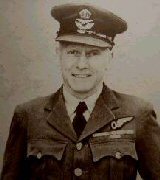Related Research Articles

Wing Commander Hubert Dinwoodie, was an officer in the Royal Air Force and a recipient of the George Cross shortly after the end of the Second World War for defusing bombs in Germany in 1946.
Captain Gerald Gordon Bell was a Canadian First World War flying ace, officially credited with sixteen aerial victories while serving in the British Royal Flying Corps and Royal Air Force.
Flight Lieutenant James Anderson Slater was a British First World War flying ace, credited with 24 aerial victories. He served in the Royal Air Force (RAF) as an instructor after the war until killed in a flying accident.

Captain Valentine Henry Baker MC AFC, nicknamed "Bake", served in all three of the British Armed Forces during the First World War. After the war he became a civilian flight instructor, and co-founder of the Martin-Baker Aircraft Company. He was the father of novelist Denys Val Baker.
Captain Frank Billinge, was a World War I flying ace credited with five aerial victories.
Captain Claud Harry Stokes was a British First World War flying ace credited with five aerial victories, all while flying the Airco DH.4.
Flight Lieutenant William Geoffrey Meggitt was a British World War I flying ace credited with six aerial victories.
Captain Thomas Sydney Sharpe was a British World War I flying ace credited with six aerial victories.
Captain Herbert James Hamilton was a World War I flying ace credited with seven aerial victories.
Douglas Alfred Savage, (1892–1967) was a British flying ace of the First World War, credited with seven aerial victories.
Captain Oliver Manners Sutton was a British First World War flying ace credited with seven aerial victories.
Major John Bowley Quested was a First World War flying ace from England. He was credited with eight aerial victories, the most notable of which was over Gustav Leffers.
Squadron Leader Anthony Herbert William Wall was a British World War I flying ace credited with sixteen aerial victories. He returned to serve in the Royal Air Force in World War II.
Group Captain Campbell Alexander Hoy was a British flying ace during the First World War, credited with eleven aerial victories. He remained in the Royal Air Force post-war and served through the end of the Second World War.
Captain Ian Patrick Robert Napier was a Scottish World War I flying ace credited with twelve aerial victories.
Captain Thomas Laurence Purdom was a Scottish World War I flying ace credited with 13 confirmed aerial victories.
Captain Frank Godfrey, was an English World War I flying ace credited with 12 victories. All his victories were achieved against German fighter aircraft.
Captain Maurice Douglas Guest Scott was a British World War I flying ace credited with twelve official victories, including one observation balloon, while a member of the Royal Flying Corps. He scored as both an aerial observer and a pilot; he was successful while serving with three different squadrons.
Captain John Stevenson Stubbs DFC AFC was an English First World War flying ace credited with 11 official victories. He was a pioneering bomber pilot who was the war's leading ace for the British Airco DH.9. He also carried off the rather unusual feat of destroying an enemy observation balloon with a bomber.
Captain William Lewis Wells was a British World War I flying ace credited with ten aerial victories. His exceptional valour twice won him the Military Cross.
References
- 1 2 "Laurence Henry Scott". The Aerodrome. 2016. Retrieved 18 January 2016.
- ↑ "No. 29083". The London Gazette (Supplement). 23 February 1915. p. 1972.
- ↑ "No. 29783". The London Gazette. 13 October 1916. p. 9875.
- ↑ "No. 29783". The London Gazette. 13 October 1916. p. 9863.
- ↑ "No. 29892". The London Gazette. 5 January 1917. p. 289.
- ↑ "No. 29837". The London Gazette (Supplement). 24 November 1916. p. 11544.
- ↑ "No. 30257". The London Gazette (Supplement). 28 August 1917. p. 8969.
- ↑ "No. 31202". The London Gazette (Supplement). 25 February 1919. p. 2808.
- ↑ "No. 31449". The London Gazette. 11 July 1919. p. 8858.
- ↑ "No. 32555". The London Gazette (Supplement). 20 December 1921. p. 10442.